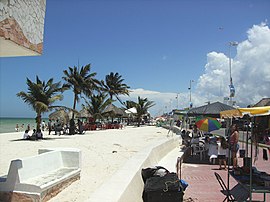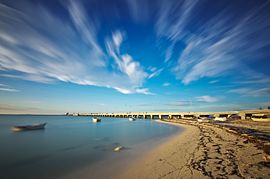Progreso (Yucatán)
| Progreso | ||
|---|---|---|
|
Coordinates: 21 ° 17 ′ N , 89 ° 40 ′ W Progreso on the map of Yucatán
|
||
| Basic data | ||
| Country | Mexico | |
| State | Yucatan | |
| Municipio | Progreso | |
| Residents | 37,369 (2010) | |
| City insignia | ||
| Detailed data | ||
| height | 1 m | |
| Post Code | 97320 | |
| Progreso Beach | ||
| Progreso Pier | ||
Progreso (German: 'progress'), also Progreso de Castro , is a port city in the Mexican state of Yucatán . The city got its nickname after Juan Miguel de Castro († 1884), the most important political advocate of port construction in the second half of the 19th century.
Location and climate
Progreso is about 35 km (as the crow flies) north of Mérida on the Gulf of Mexico in the hot, humid climate of the Caribbean . The place is less than once per decade of cyclones ( hurricanes striped), so that to date the damage in moderation stopped. In 1900 Progreso had about 5,000 inhabitants; today there are almost 40,000.
economy
The city was built as the port of Mérida and was mainly used for the export of sisal fibers and fishing. As early as 1895, the approximately two-kilometer-long Progreso pier was built as a jetty for landing the ships . So that large ships can also dock, the pier was extended to 6.5 kilometers in the late 1930s, making it one of the longest in the world. It allows the mooring of container ships as well as cruise ships .
In addition to its function as a port, Progreso is also a popular destination for the residents of Mérida. The beaches in the area are also popular, but the heat - despite the light sea breeze - is often unbearable, especially during the midday hours.
Surroundings
The Mayan ruins of Dzibilchaltún and Xcambó, which are worth seeing, are about 20 kilometers to the south-east and 37 kilometers to the east.
In the 19th century, the entire area was more densely populated. In many places there were extensive sisal plantations ( Misnebalam, Xtul, Santa Elena etc.), which were abandoned after the end of the Mexican sisal boom (1950/60) and are now in ruins.
Sons and daughters
- Luis Miguel Cantón Marín (1938–1990), Bishop of Tapachula



